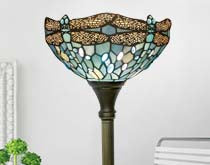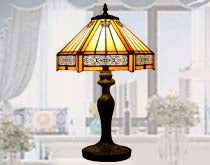A guide to collecting Tiffany lamps
First seen in the late 1890s, the Tiffany lamp , a stained glass lamp was an important art of the late 19th century, attracting countless collectors from around the world. Tiffany's main inspiration is nature, and all the flowers are fully reflected in the stunning lighting design.
1. Origin of Tiffany lamps
Louis Comfort Tiffany (1848-1933) not to be confused with his father, Charles Tiffany, who founded the famous jewelry brand Tiffany & Company, was an artist, decorator and designer. After a successful career as a painter and interior designer, Louis decided to turn his attention to the design and production of stained glass, with his factory located in Queens, New York.
2. Superior craftsmanship
Tiffany hired the finest American artisans of the time and experimented with his aesthetic concepts on stained glass. The making of the lampshades was a painstaking process, with each small piece of glass sourced from thousands of drawings selected by the cutting department. Its lampshades present a harmony of different colors, with subtle shades presenting intricate patterns.
3. The base of the lamp
The base is a key part of the design; most are made in bronze by Tiffany's foundry in Queens, while some are decorated with enamel or mosaic. Many of the designs follow certain natural laws as a base; for example, wisteria is always paired with a trunk base, but most dragonfly lamps can be paired with a variety of bases.
4. Can the lights be rewired?
Rewiring is perfectly acceptable and will not affect the value. However, it is very important to ensure that the lamp can be used safely and the collector should match the vintage wiring, which will be more beautiful.
5. The most expensive Tiffany lamp at auction
Pink Lotus Tiffany Studios circa 1900-1910 Sold at Christie's in 1997 for $2,807,500
The most valuable Tiffany "Pink Lotus" ever sold at Christie's in 1998 for $2.8 million, setting a record for the world's most expensive lamp. Its design encompasses many elements and features a colorful mosaic decorative base.
6. Evaluate the completeness of the lamps?
As with any collection, the condition of the lamps is important. tiffany lamps have a 100 year history and are rarely intact. For experienced collectors, the usual cracks are perfectly acceptable. However, it will be different if the glass is missing. tiffany lamps are characteristic of the art nouveau style, in the shape of figures sometimes used to decorate the body of the lamps. Sometimes the missing glass, but the beautiful shape will likewise not affect the price.
Translated with www.DeepL.com/Translator (free version)
7. Do restored lamps affect the value?
It is important to check lamps for signs of restoration, but it can be difficult to detect. An older restoration will not be as neat, clean and seamless as a new restoration. A good restoration may not affect the value.
8. Is it good to mix and match Tiffany lamps with today's interior style?
Tiffany lamps are also very popular in New York today and are still sought after by collectors. These lamps are one-of-a-kind works of art, just like paintings or sculptures. But the difference between a painting or sculpture is that a Tiffany lamp can be the focal point of a room.























